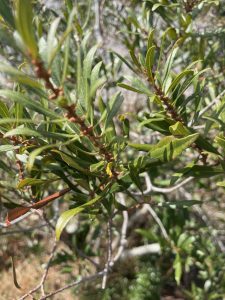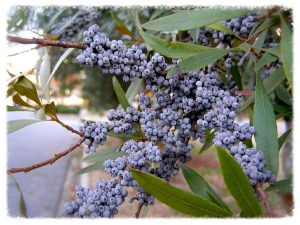
Wax myrtle (Myrica/Morella cerifera) is one of those evergreen shrubs that mostly lives out its life in the background. Neither tall and imposing (on average, up to 12’; rarely as tall as 20’), nor full of showy flowers, it is nonetheless an important native species. Behind that low-key persona is a small tree that has played numerous roles in American history. Also known as bayberry, wax myrtle grows in low-lying areas along the edges of wetlands. It is a fast grower and will fill in open spaces if there is enough available light. Wax myrtle is a hardy plant, highly tolerant of salt, and works well in pollinator gardens and urban locations. Both male and female plants are necessary to produce numerous berries, which grow directly on the plant stem. A wide variety of birds use the plants as nesting areas and feed on the berries, including warblers, swallows, wrens, and turkeys.

People have long planted wax myrtle shrubs as natural privacy screens, or used an extract from the leaves as a mosquito repellent. The leaves are tough, similar in texture to live oaks, helping hold in water for drought tolerance and keep out salt, enabling them to thrive in coastal areas.

The leaves and berries serve several useful purposes for humans. Native American tribes, particularly the Seminoles in Florida, would use fermented leaves as a medication for headaches and fevers. The berries are a greenish gray/blue color and are the size of BB’s. Each shrub can grow hundreds of small berries along each branch, and berries have a waxy coating that will separate from the berry flesh when boiled. Early American settlers would collect this wax and reform it into bayberry candles. They would serve a dual purpose in providing both light and mosquito protection. In those early days, mosquito-borne diseases like yellow fever and malaria were both common and deadly, so it was a matter of survival. The plants have also been used to deter fleas and cockroaches.
According to several native plant enthusiasts who posted bayberry-candle-making videos on YouTube, the rule of thumb is that you’ll need to collect a gallon of wax myrtle berries to create a cup of wax. Besides candles, early settlers also used the wax for soap, sealing wax, and shaving cream. Be mindful that wax myrtle plants are flammable, so it is recommended that if planted in a home landscape, they are in an area safely away from the building walls.
 9
9
